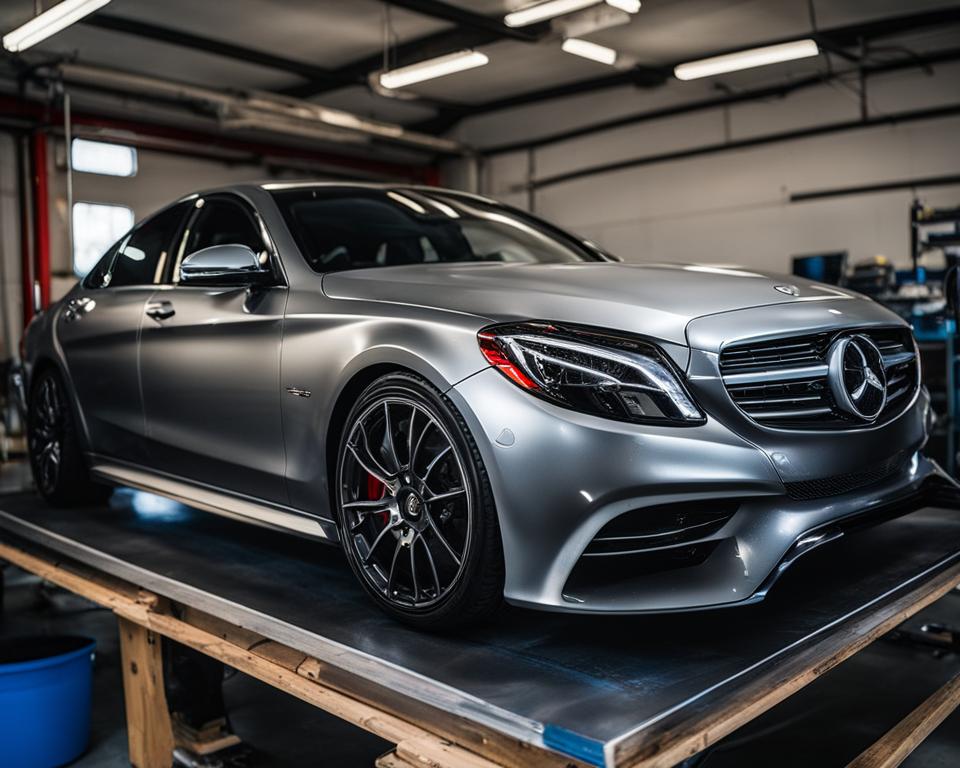As a vehicle owner, it’s important to maintain the beauty and integrity of your vehicle’s finish. One way to achieve this is through paint correction, a process that removes imperfections from the paint surface, resulting in a flawless and restored appearance.
When considering paint correction, one of the key factors that comes to mind is the cost. Understanding the cost of paint correction in 2024 is essential for budgeting and planning. In this article, I will discuss the factors that affect paint correction prices, what you can expect in terms of cost, and why it is worth investing in professional paint correction services.
Factors Affecting Paint Correction Cost
When it comes to paint correction, the cost can vary based on several factors. These factors play a crucial role in determining the overall expense of the service. Let’s explore the key factors that influence the cost of paint correction:
1. Vehicle Size
One of the main factors that affect the cost of paint correction is the size of the vehicle. Larger vehicles, such as SUVs or trucks, generally require more time, effort, and resources to achieve optimal results. As a result, the price for correcting the paint on larger vehicles is typically higher compared to smaller ones.
2. Vehicle Type
Another important factor is the type of vehicle that needs paint correction. Different vehicle types, including sedans, coupes, SUVs, and sports cars, have varying surface areas and body designs. These unique aspects can impact the complexity and level of effort required for the paint correction process. Consequently, the cost will vary depending on the specific vehicle type.
3. Condition of the Vehicle’s Paint
The condition of the vehicle’s paint is a critical consideration in determining the cost of paint correction. The presence of swirl marks, scratches, oxidation, and other imperfections can significantly affect the level of correction required. More severe paint damage may necessitate additional work, specialized techniques, or extensive restoration, resulting in higher costs.
4. Location
The location of the detailing service also plays a role in determining the cost of paint correction. Prices can vary based on the region, with larger cities tending to have higher costs due to factors such as supply and demand. Additionally, the cost of living and local market dynamics can influence the pricing structure in different locations.
By understanding these factors, you can better gauge the cost of paint correction for your vehicle. Keep in mind that the quality and expertise of the detailer also contribute to the overall cost. It’s essential to choose a reputable professional who can provide a comprehensive evaluation and deliver exceptional results.
| Factors | Impact on Cost |
|---|---|
| Vehicle Size | Higher cost for larger vehicles |
| Vehicle Type | Varies based on the specific vehicle |
| Condition of the Vehicle’s Paint | More severe damage may lead to increased cost |
| Location | Prices may be higher in larger cities |
Benefits of Paint Correction
Paint correction offers numerous benefits that can greatly enhance the overall appearance and condition of your vehicle. By effectively removing imperfections such as swirl marks, minor scratches, and hazing, paint correction leaves the exterior looking flawless and pristine. This process not only improves the appearance of your vehicle, but it also increases its overall value.
In addition to removing imperfections, paint correction provides protection against external elements that can damage your vehicle’s paint job over time. The clear coat applied during the correction process acts as a barrier, shielding your vehicle from harmful UV rays, dirt, and debris. This protective layer helps to maintain the paint’s vibrant color and prevents premature fading.
Investing in paint correction is not only a wise decision for the preservation of your vehicle’s appearance, but it is also a great long-term investment. By maintaining the condition of your vehicle’s exterior, you can save money on potential repairs and repainting in the future. A well-maintained exterior significantly increases the value of your vehicle, making it a worthwhile investment.

The Benefits of Paint Correction at a Glance:
- Removes imperfections such as swirl marks and scratches
- Improves the overall appearance of the vehicle
- Protects the exterior from external elements
- Preserves the value of the vehicle
- Long-term cost-saving investment
By considering the benefits of paint correction, you can make an informed decision to enhance the appearance and value of your vehicle.
| Benefits | Description |
|---|---|
| Remove imperfections | Eliminates swirl marks, minor scratches, and hazing for a flawless exterior |
| Improve appearance | Enhances the overall look of the vehicle, restoring its original luster |
| Protect from external elements | Acts as a barrier against UV rays, dirt, and debris, preventing damage |
| Great investment | Prolongs the life and value of the vehicle, saving money in the long run |
| Increase value | Boosts the resale value of the vehicle due to its improved condition |
Paint Correction Process and Techniques
Paint correction involves a meticulous process and the use of various techniques to restore a vehicle’s paint to its original condition. This process typically includes machine polishing, which effectively eliminates unsightly scratches, swirl marks, and other imperfections from the clear coat.
Professional detailers employ a combination of polishing compounds, pads, and proven techniques to achieve the desired results. Each vehicle’s unique needs and characteristics may require different products and methods, making the expertise of a skilled detailer invaluable in delivering a high-quality paint correction service.
Machine polishing is a vital step in the paint correction process. It involves the use of advanced polishing machines, such as dual-action or rotary polishers, to precisely remove imperfections and restore the paint’s clarity and shine. The detailer carefully selects the appropriate polishing compounds, which can range in abrasiveness, to address specific issues in the paint.
The paint correction process begins with a thorough inspection and evaluation of the vehicle’s paint condition. The detailer identifies any swirl marks, scratches, oxidation, or other defects that need correction. They then determine the appropriate polishing techniques and products to achieve the best results.
Once the preparation and evaluation are complete, the machine polishing begins. The detailer carefully guides the polishing machine over the surface, working in small sections to ensure even coverage. They apply the selected polishing compound onto a foam or microfiber pad, which helps remove imperfections while minimizing the risk of damaging the paint.
The detailer adjusts the speed and pressure of the machine to optimize the paint correction process. They work methodically, gradually refining the surface until the desired level of correction is reached. This intensive process requires skill, experience, and expertise to achieve consistent and outstanding results.
Throughout the paint correction process, the detailer regularly inspects the work, ensuring that the imperfections are thoroughly eliminated, and the paint achieves a flawless finish. Once the machine polishing is complete, the vehicle’s paint is ready for further protection and enhancement, such as the application of a sealant or ceramic coating.
Benefits of Machine Polishing:
“Machine polishing is a highly effective technique that offers numerous benefits for paint correction. It allows detailers to tackle a wide range of imperfections, from minor scratches to deep swirl marks, effectively restoring the paint’s original beauty. By utilizing advanced machines and techniques, machine polishing delivers consistent and exceptional results.”
Overall, the paint correction process, including machine polishing, plays a crucial role in transforming and rejuvenating a vehicle’s paintwork. It involves the use of specialized products and skilled techniques to eliminate imperfections and restore the paint’s luster. Hiring a reputable and experienced detailer ensures that your vehicle receives the highest-quality paint correction service for stunning results that exceed your expectations.

DIY vs Professional Paint Correction
When it comes to restoring your vehicle’s paint, you have two options: DIY paint correction or hiring a professional detailer. While the DIY route may seem appealing, it’s important to consider the advantages and disadvantages of both approaches.
DIY Paint Correction
DIY paint correction involves using kits that are readily available online. These kits typically include various compounds, pads, and instructions to guide you through the process. While DIY options may be more cost-effective for minor imperfections and touch-ups, there are some downsides to consider.
“The DIY approach to paint correction can be tempting, but it’s essential to have realistic expectations. Without the proper skills and equipment, you may end up with subpar results and potentially damage your vehicle’s paint.”
- Advantages of DIY Paint Correction:
- Cost-effective for minor imperfections and touch-ups
- Convenient option for enthusiasts who enjoy working on their vehicles
- Allows you to learn and develop skills in paint correction
- Disadvantages of DIY Paint Correction:
- Requires a significant investment in tools and products
- May result in subpar results if not done correctly
- Potential to damage the vehicle’s paint if not skilled in the appropriate techniques
Professional Paint Correction
On the other hand, hiring a professional detailer for paint correction offers several advantages. These experts have the experience, skills, and equipment necessary to achieve superior results and restore your vehicle’s paint to its former glory.
“Professional detailers have the knowledge and expertise to accurately assess the condition of your vehicle’s paint and determine the level of correction needed. They have access to advanced tools and products and know the right techniques to deliver outstanding results.”
- Advantages of Professional Paint Correction:
- Superior results due to the skills and experience of professional detailers
- Accurate assessment of paint condition and level of correction needed
- Access to advanced tools, products, and techniques
- Disadvantages of Professional Paint Correction:
- Higher cost compared to DIY options
- Less hands-on involvement for enthusiasts who enjoy working on their vehicles
- Scheduling and availability may vary based on the detailer’s workload

Conclusion
Paint correction is an essential part of vehicle maintenance that can significantly enhance the appearance and value of your car. By hiring a professional detailing service, you can ensure that your vehicle receives a high-quality paint correction that yields long-lasting benefits.
While there may be an upfront cost associated with paint correction, it is a worthwhile investment in the overall maintenance and condition of your vehicle. Regular paint correction not only protects your vehicle’s exterior from environmental factors but also extends the lifespan of the paint job.
By addressing imperfections such as swirl marks, minor scratches, and hazing, paint correction improves the overall appearance of your vehicle, ultimately increasing its value. It also provides protection against harmful elements like UV rays, dirt, and debris that can damage the paint over time.
Consider professional paint correction as a crucial step in maintaining the exterior of your vehicle and preserving its value. With the expertise and skill of a professional detailer, you can expect impressive results and long-term savings by avoiding potential repairs in the future.
FAQ
How much does paint correction cost?
The cost of paint correction can vary depending on several factors. On average, you can expect to pay between 0 and 00 for a paint correction service.
What factors can affect the cost of paint correction?
Several factors can influence the cost of paint correction, including the size and condition of the vehicle, the level of correction needed, the skills of the detailer, and the location.
What are the benefits of paint correction?
Paint correction can remove imperfections, improve the appearance of the vehicle, protect it from external elements, and increase its value.
What is involved in the paint correction process?
The paint correction process typically includes machine polishing, using polishing compounds, pads, and specific techniques to remove scratches, swirl marks, and other imperfections from the clear coat.
Should I perform DIY paint correction or hire a professional?
While DIY options may be more cost-effective for minor imperfections, hiring a professional detailer offers several advantages, such as experience, skills, and equipment to achieve superior results.
Why is paint correction important for vehicle maintenance?
Paint correction enhances the appearance and value of a car, protects the exterior from environmental factors, extends the lifespan of the paint job, and ultimately saves money on potential repairs in the future.


